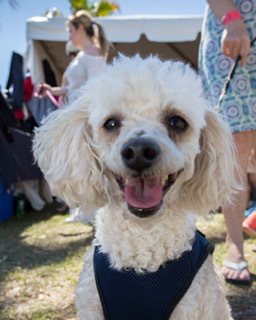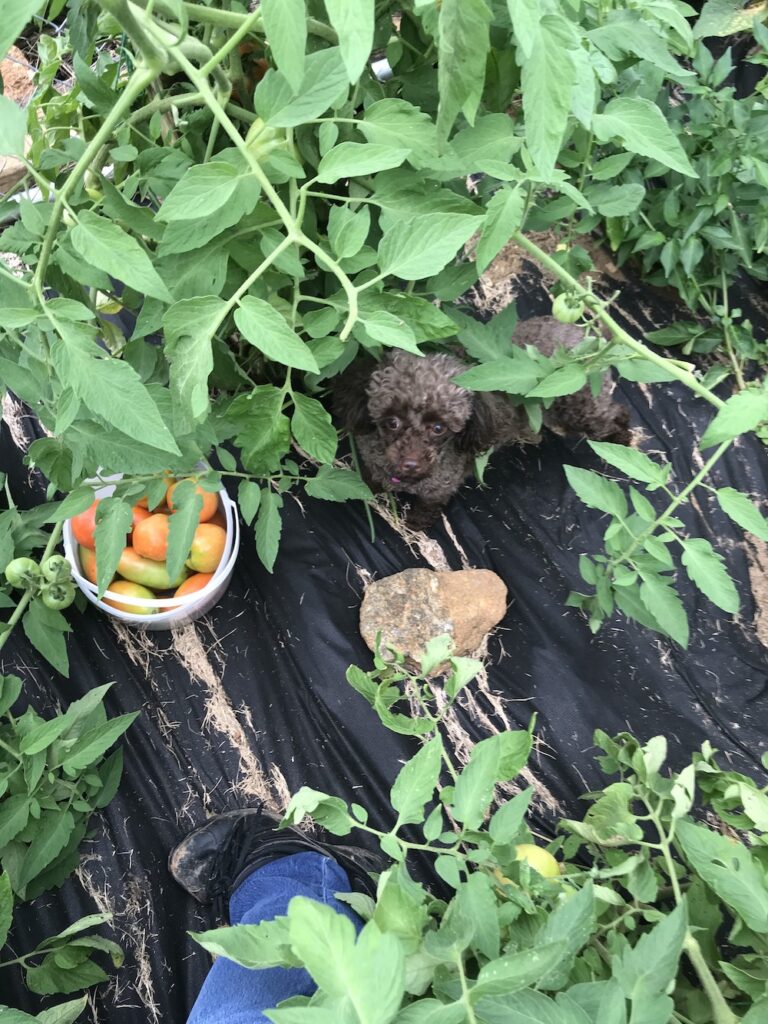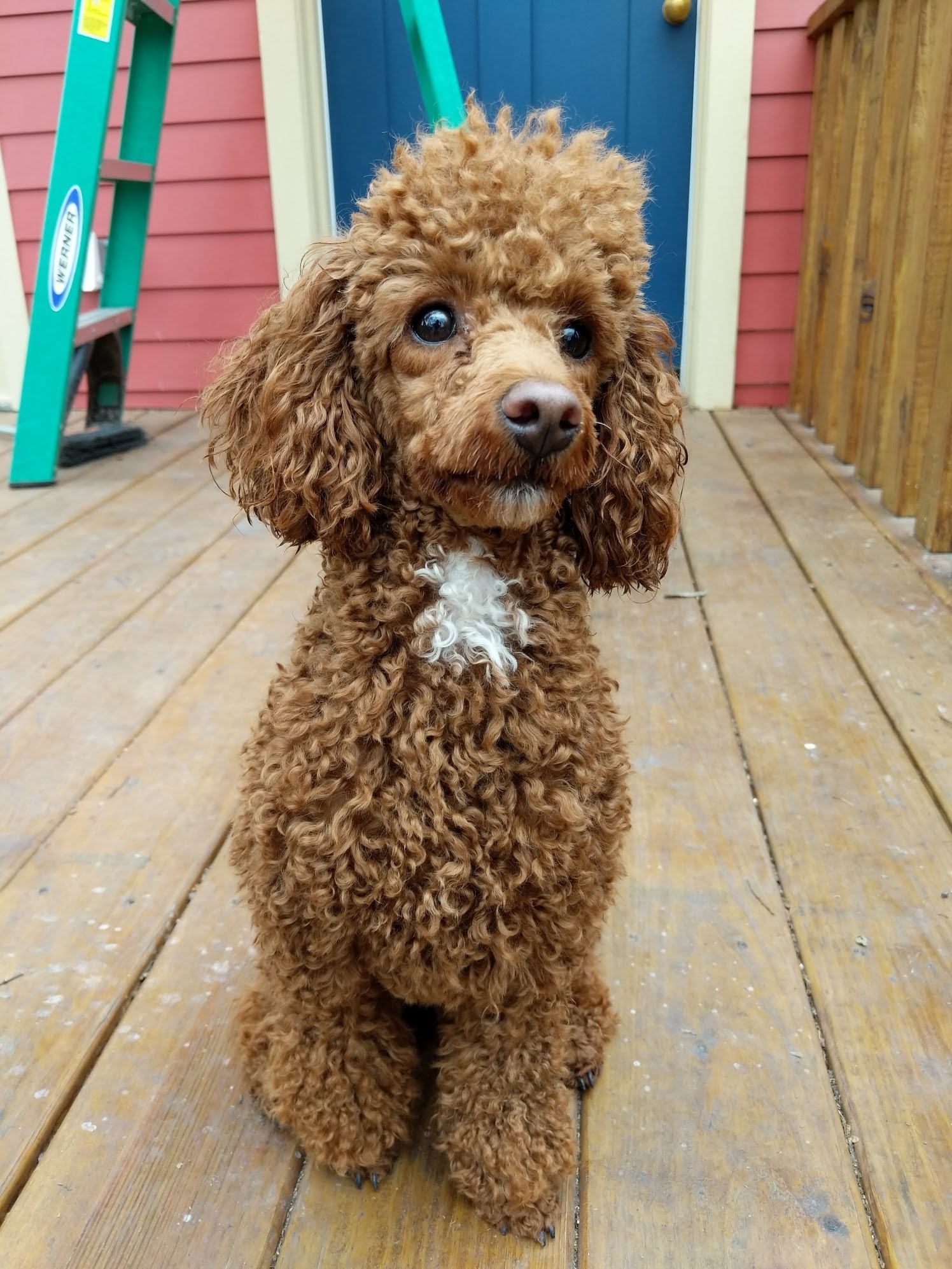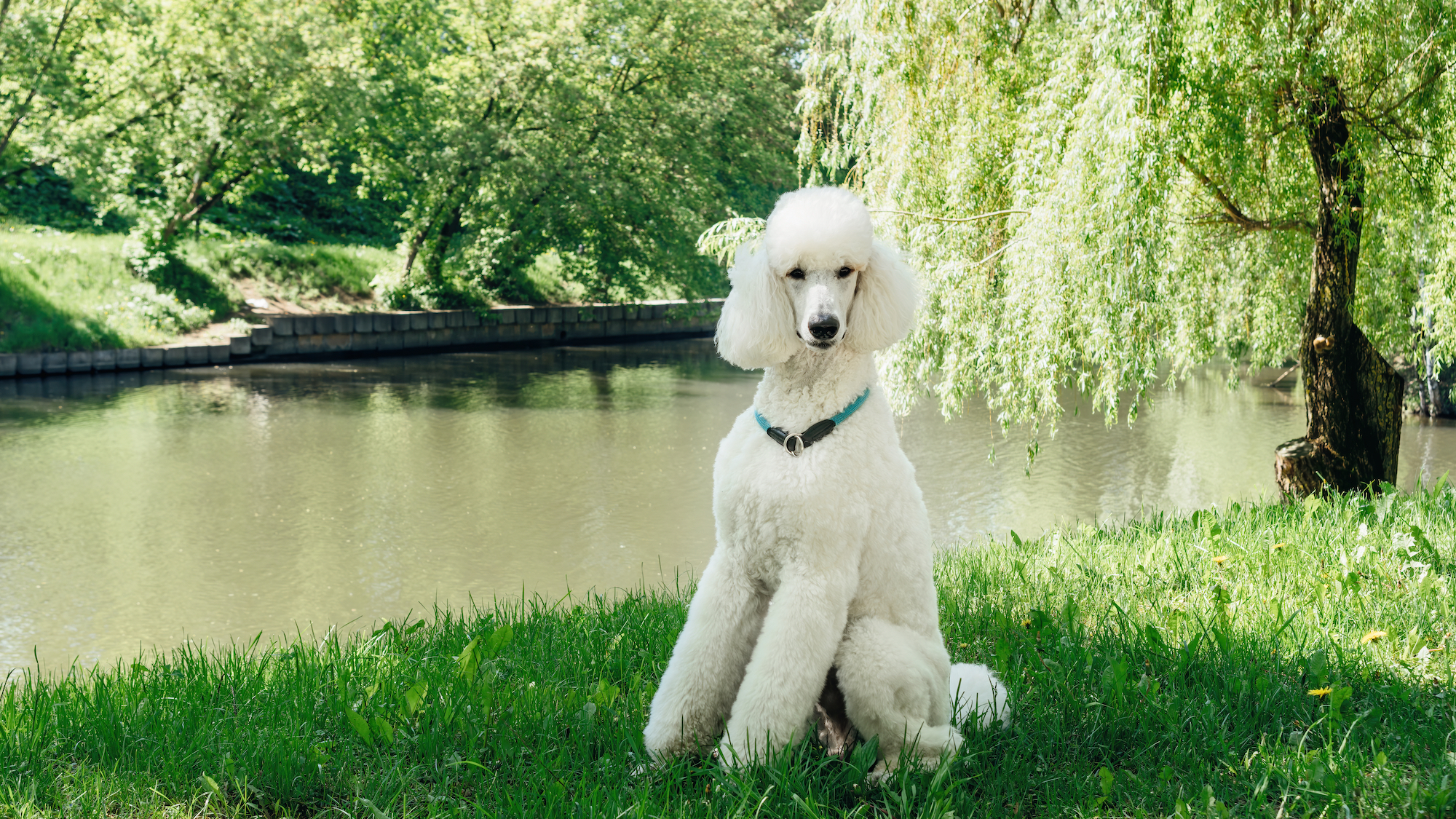When some humans picture a poodle, they think of a froufrou show dog trotting around a ring. And, sure, some members of the breed have excelled in such competitions. But there is much more to these intelligent, athletic dogs. The Poodle’s original job was to retrieve ducks out of the water, and today’s companion poodles retain the smarts and agility that made them effective at such work. Here’s a primer for those considering bringing a poodle home, or looking to improve their relationship with the one they already have.
Basic poodle facts
The American Kennel Club officially recognizes three sizes of poodle: standard, miniature, and toy. Some organizations elsewhere in the world count a fourth variety, the “medium poodle,” which is between a standard and a miniature. A male standard poodle usually weighs 60-70 pounds, while a female is often in the 40-50 pound range. A miniature weighs 10-15 on average, while a toy ranges from 4-6. The AKC lists the average lifespan for all poodles as from 10 to 18 years. Their curly coats require dedicated attention to grooming—daily brushing if you let it grow long, and regular trimming to keep it short if not.
“What are the differences between the poodle sizes?”
It depends who you ask. Anecdotally, some humans will tell you that miniature and toy poodles are “goofier,” “yappier,” “brattier,” and the like. Others, though, will tell you that it just depends how you raise them. The Poodle Club of America says that “Miniatures and Toys have been bred down from the larger Poodles and they exhibit the same general characteristics.”
“Should I get a poodle?”
A poodle will make a great addition to a home that’s ready for one—but you should know that they require a big commitment from their humans, including consistent grooming, daily exercise, and ample enrichment. That goes not only for the standard, but even the toy. A tiny four-pound poodle still has a very active mind and will need physical and mental challenges. If you’re up to the task, a poodle will repay you with years of loyalty and companionship.
Poodle breed history
The poodle originally hails from Germany, where the breed’s representatives have retrieved waterfowl for hundreds of years, excelling at their job due to intelligence, strong swimming ability, and soft mouths to carry prey. Poodles also became popular performers in European circuses, which is where they were first bred down to the miniature size—smaller poodles were easier to transport.
Poodles have been a favorite of the upper crust for a long time, and by the 18th Century they found themselves keeping European nobility company, especially in France. Poodles eventually became that country’s national dog.
Across the pond in the United States, the breed acquired a similarly highbrow reputation. One powerful illustration of this fact is the story of Masterpiece, a prized show poodle who went missing, possibly kidnapped, in 1953. Whatever the specific circumstances of Masterpiece’s disappearance, it’s certain that his owner bred him to achieve the ambition of winning titles in confirmation, obedience, and agility—and he did. The dog was so highly valued that a Pakistani prince who wanted to buy him offered his owner, Alexis Pulaski, a sum equivalent to $250,000 today. Pulaski refused. Most poodle owners can probably relate. Today, they remain popular companion dogs—all told, the AKC ranks them as the seventh most-popular dog breed by registration.
Because they tend to be smart, friendly, and trainable, poodles thrive at a wide variety of jobs. Poodles can be wonderful therapy dogs—in this highly publicized example, one poodle was such a natural that she took up the job without any formal training.
The poodle is prominent in pop culture. To name just a few representatives: Fifi belongs to the Finsters in Rugrats. Rhapsody in White is one of the things Leslie and Sheri Ann Cabot have in common in Best in Show, along with an affinity for soup, the outdoors, snow peas, talking, and not talking. And, in 2003, Weird Al Yankovic released an album entitled Poodle Hat, on whose cover a poodle sits atop his head in place of a hat. Some poodle scholars would tell you that this was not an especially important moment in the history of the breed, but we thought we’d let you know.
“What’s with the poodle haircut?”
Poodles’ show-ring look did not originate as a mere fashion choice; long ago, hunters wanted their dogs to keep warm in the water while still moving nimbly—to achieve this, they shaved only around their poodles’ joints, leaving big, insulating puffs elsewhere. So the approved official ‘dos for show poodles have a link to a practical purpose. Still, many observers will confirm that they do look quite fancy.
Poodle personality
Jan Williams, who shares her life with a poodle named Beauregard, aims to dispel certain breed myths right off the bat: “Many men,” Williams says, “claim they don’t want a ‘froufrou poodle.’ A standard poodle, however, is not froufrou. A standard poodle is an example of intelligence, power, grace, and numerous abilities rolled into a regal body. What most men are surprised about is their clownish behavior coupled with athleticism and stamina. Once owned by a standard poodle, desire for other breeds quickly fades.”
Poodles of all sizes inspire such passionate loyalty among their humans, due to their intelligence, energy, and propensity for forging strong emotional bonds. They tend to be very affectionate with their families. Joanne Buchhop, who lives with a poodle named Danny, says: “If Danny were a person, he would be what is called an HSP (a Highly Sensitive Person). He can pick up on the moods of his humans and respond accordingly. I started kissing him on the ear before bed when he was a puppy, and now when I am having a bad day he will come and ‘kiss’ my ear.” Kenneth Hamburger, whose poodle is named Penny, says “she seems to worry about [his family.]” He explains: “She is there in a flash if I have a sneezing fit, and will lay down on my husband’s feet and calm him if he seems upset.”
Poodles also usually get along with well-behaved children. Still, you should always supervise interactions between dogs and kids, and make sure your whole family practices proper dog etiquette. No dog is likely to take kindly to being roughhoused.
Poodles are very sharp, and extremely trainable. But sometimes they may put their intelligence to work on tasks that you didn’t have in mind. Addie Walsh says that her poodle, Lulu—who also goes by Monkey—frequently outsmarts humans and fellow canines in pursuit of food. “Once,” she recalls, “I was giving out treats to all my dogs and Lulu/Monkey started barking at the front door. No one was there, but the other dogs assumed there was. They ran to the door, barking. Lulu immediately took advantage, seizing their treats while they were distracted.”
They’ll pick up on your cues quickly, too. Donna Davidson, who owns a poodle-bichon mix named Micah, says that “he is always looking at our shoes after we get dressed to see if we have on our walking shoes. If we do, he can hardly be contained—he is so excited.”
Of course, every dog is an individual—so don’t take for granted that your poodle will conform to the expectations people have for the breed. Noralee Sherwood says that her poodle, Otto, “is not the brightest bulb. But what he lacks in intelligence, he makes up for with his sweet disposition. He knows the basic commands, but otherwise he is mostly a free spirit.” Prepare to love and look after the dog you have.

Cesar
Poodle training
Dr. Stanley Coren’s dog-intelligence ranking—which measured how quickly and consistently dogs obeyed commands—has poodles in second place, just behind the vaunted border collie. Per his research, they’re likely to learn a new command in five repetitions, and to follow it almost every time. These capabilities are a huge plus, but you must make sure to use them; a poodle can become bored and destructive if not given enough to think about. As such, it’s a very good idea to take yours to classes and engage them in regular training throughout their lives.
If you’re consistent, kind, and patient with your poodle, you may be amazed at what they can do. Marianne Dewling, who lives with a poodle named Eloise, certainly was. “She can select a toy just by its name,” she says. “I never thought that our poodle could develop a vocabulary.” Poodles can master all sorts of occupations. As mentioned before, they often make effective therapy dogs. They’ve been used in truffle hunting. And, though we do not recommend sending yours to the circus, the reason they were part of said shows in the past is because they can remember and execute a wide variety of tricks. Chances are that if you concentrate, use treats, and fuss over your friend when they get it right, they’ll have a great time building up a repertoire.
Poodles, like other dogs, contain multitudes. Remember Monkey, from earlier? Walsh recalls one particular encounter she had with a stranger on the Upper West Side in New York City, who she met by chance on the sidewalk. “The woman started to cry as she petted Monkey,” Walsh says, “saying that Monkey had visited her dying mother at Sloan Kettering more than once. The woman couldn’t get over how Monkey would lift her mother’s spirits. It was a very moving meetup—until I noticed that Monkey had her nose in the woman’s purse, looking for food.”

Penny
Healthy lifestyle for poodles
Exercise
Poodles are energetic, so they—and their humans—are bound to be happier if they get daily exercise that goes beyond just a couple of short walks to do their business. Considering that poodles were historically used as waterfowl retrievers, you might want to see if yours takes to fetch. For similar reasons, many poodles love to swim. Some poodles become champions at organized activities like agility or tracking. But you can keep yours in shape with any safe undertaking that they seem to enjoy. An adult standard or miniature poodle can be a good running partner at an appropriate distance; the toy is a different story, thanks to tiny legs. Anette Dworkin, who owns a poodle mix named Mitzi, says: “Mitzi is 13 years old with the energy of a very young dog. We walk three miles daily, but she prefers to run instead.”
One way or another, poodles of all sizes need enough of a workout each day. “A small poodle may get all of the exercise that it needs from running around inside of a house,” says Jessica Blouin Clark, a board member at the Poodle Rescue of Vermont, “but a standard poodle may require several long walks per day.” Talk to your vet about a plan that strikes the right balance for your dog’s size and age. Because of poodles’ active minds, it’s best if you find a way to challenge their intellects as well. At home, feeding them from puzzle bowls can give them a bit more to think about.
Grooming and bathing
You’ll have to stay on top of caring for your poodle’s hair. If you go with one of the showy styles, brush your pal everyday. If you make it a positive experience by offering treats and taking it slow, chances are they’ll enjoy the bonding time. Otherwise, if you want to keep your poodle’s curly single coat short, plan to trim it yourself or bring them to the groomer as often as once a month or as infrequently as every other month. You can bathe them about that often, too. “Brushing between grooming appointments,” says Clark, “will make the groomer’s job much easier.”
Lourdes Cabrera brings her poodle, Dexter, to the groomer every other week. “I wish I knew how much grooming was required to keep him looking his best,” she says. “His hair is very thin and curly, and it mats and tangles very easily.” While some aspects of the poodle’s coat require more attention than most dogs, there is one respect in which it is low-maintenance: there are not really any hypoallergenic dogs, but poodles do not shed much.
Common poodle health problems
Hip dysplasia: This is a condition in which the ball and socket of the hip joint do not fit together properly, which could lead to arthritis or degenerative joint disease. Because hip dysplasia can cause your dog pain or cost them the use of the impacted joint, it’s important that your vet pays close attention to your poodle’s hips during checkups. If you notice symptoms like a newly limited range of motion, diminished willingness to move around or climb stairs, hopping, pain, or limping, have a vet check your dog out.
Eye problems: Toy and miniature poodles are among the breeds who may have a higher incidence of progressive retinal atrophy, a genetic disease that causes degeneration of the retina and leads to blindness. There is no effective treatment. Poodles can also be struck by other eye ailments, including cataracts and a rare genetic defect called optic nerve hypoplasia that can leave dogs blind or with impaired vision. Breeders should perform genetic tests for possible ocular issues, and all poodles should receive eye exams.
Epilepsy: Poodles can inherit idiopathic epilepsy, or epilepsy with no apparent underlying cause. Seizures can also be caused by a variety of other conditions. They’re a serious issue, and if they arise you should seek veterinary attention. The sooner a dog with epilepsy gets treatment, the better. A delay might make helping them more difficult, and could even be fatal.
Addison’s disease: Poodles are among the breeds at an increased risk of this condition, in which a dog’s adrenal glands do not produce enough of the hormones cortisol and aldosterone. Dogs with Addison’s may show symptoms like vomiting, increased thirst and urination, diarrhea, lethargy, shaking, and weight loss. If any of these signs arise, bring your dog to a vet so that they can perform an examination. Most dogs with Addison’s can live normal, healthy lives with treatment, which usually involves medication.
Legg-Calve-Perthes: This degenerative condition, which is more common in miniature and toy poodles, impacts the head of the femur—the “ball” of the “ball-and-socket” hip joint. It may be caused by a lack of blood supply to the bone, and because it seems to be hereditary it’s not possible to prevent it. If you notice your dog limping—usually on one leg—or showing signs of pain, contact your veterinarian, who can use a physical exam and imaging tests to make a diagnosis. Depending on the disease’s progression, a vet may advise rest, medication, or surgery and rehabilitation to help improve a dog’s quality of life. Dogs with this condition should not breed, as they might pass it on to their puppies.
Patellar luxation: This is a condition in which a dog’s kneecap slips out of place. Symptoms to watch for include your poodle picking up one leg and seeming to skip for a few steps, then kicking a leg out to pop the knee back into place. This is more likely in miniature and toy poodles than in standards. Severe patellar luxation can require surgery, but a vet may be able to treat a milder case with medication.
Bloat: Poodles may suffer from bloat, also known as gastric dilatation-volvulus (GDV). It’s a life-threatening condition that requires immediate medical attention—minutes can make the difference. If you notice a distended abdomen, retching, or signs of pain, contact a veterinarian as soon as you can. Out of poodle sizes, bloat is most common among standards. For much more about bloat, read our guide.
Von Willebrand’s Disease (VWD): Dogs with this inherited disorder don’t have enough of a protein that helps blood clot. While some dogs with VWD will not show symptoms, others may bruise or bleed excessively. Injuries and surgeries are particularly dangerous for dogs with this issue. If you’re getting a poodle with a known genetic history, ask whether they’ve been screened for it—and if you already have a poodle who hasn’t been screened for VWD, talk to your vet about it. Knowing that a dog has VWD will impact how vets treat injuries, which medications they prescribe, and their approach to surgical procedures.
Sebaceous adenitis: Standard poodles are more likely to develop this disorder, in which the immune system attacks the sebaceous glands and causes symptoms like hair loss, scales, brittle hair, and lesions. It can also sometimes lead to painful infections. If your poodle shows signs of this illness, contact your vet. While it can be difficult to treat, certain medications can help manage symptoms and make a dog more comfortable.
Collapsing trachea: If you notice that your dog frequently has a dry cough, and that it gets worse with pressure—for example, from a collar—when they’re excited, or when they’ve just had food or drink, you should talk to their veterinarian. Small-breed dogs like toy poodles are more likely than others to suffer from tracheal collapse. This problem could make it hard for them to get enough air—so you should seek medical attention as soon as possible. Medication and surgery can help alleviate the condition, though dogs with tracheal issues may require treatment throughout their lives. Some steps humans can take to help their dogs at home include keeping them at a healthy weight, protecting them from irritants like smoke, and switching from a collar to a harness on walks.
Dental problems: Like many other dogs, poodles can suffer from periodontal disease. Because this often impacts the roots of their teeth, a vet may need to perform X-rays to detect it. Be sure that your vet regularly examines your dog’s teeth during checkups, get professional cleanings if necessary, and institute a daily toothbrushing routine at home.

Liberty
Food and nutrition for poodles
Like any other dog, poodles need digestible, complete, and balanced food that supplies enough energy for daily activities while helping maintain a healthy weight. A pre-portioned meal plan can supply a boost on all of these fronts.
Support joint health: A fresh diet that provides balanced Omega-3 fatty acids could be an asset as you seek to ward off joint issues. A pre-portioned fresh food plan also makes it easy to feed the right number of calories every day. This helps maintain a healthy weight, which is another big factor in keeping joints healthy and staving off a whole raft of other health issues.
Mind the teeth: Eating for dental health means eating for overall health—a fresh, whole-food diet promotes a healthier immune system, which helps ward off dental maladies. Crunchy kibble is often said to clean teeth, but it does no such thing. In fact, kibble is an ultra-processed food and as such can contain substances that actually fuel inflammation in the body, including in the tissues of the mouth. Most kibble is starchy and full of fillers that break down to sugar, which contributes to plaque and bacteria.
High-quality food for high-quality poops: A diet of fresh, lightly cooked food has been shown to be more digestible than processed kibble, and can promote a healthy gut and good digestion (which also means better, smaller poops).
A healthy diet—alongside ample exercise, training, vet care, and as much fetch as they want—is among the keys to giving your poodle a happy life.
Where to get a poodle
If you have decided to get a poodle of your own, a good place to start is a rescue like Poodle Rescue of Vermont.
The post The Poodle Care Guide: Personality, History, Training, Food, and More appeared first on The Farmer's Dog.





Comments
Post a Comment